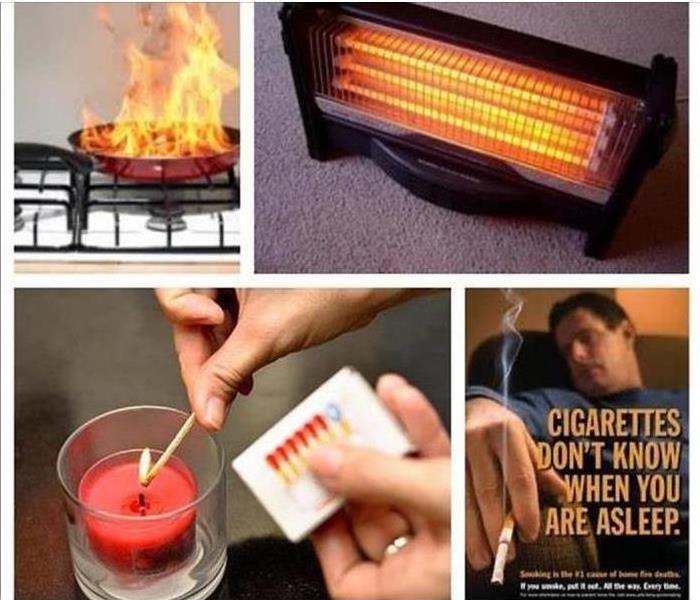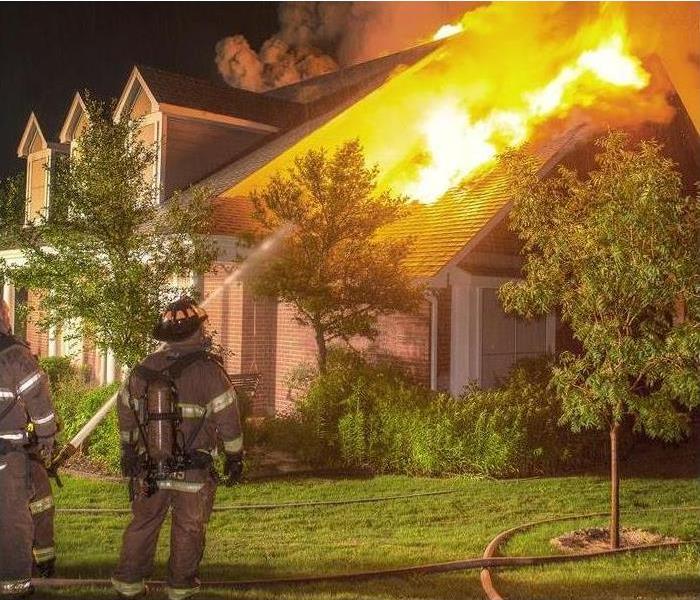Archived Fire Damage Blog Posts
Workplace Fire Safety Tips
8/24/2022 (Permalink)
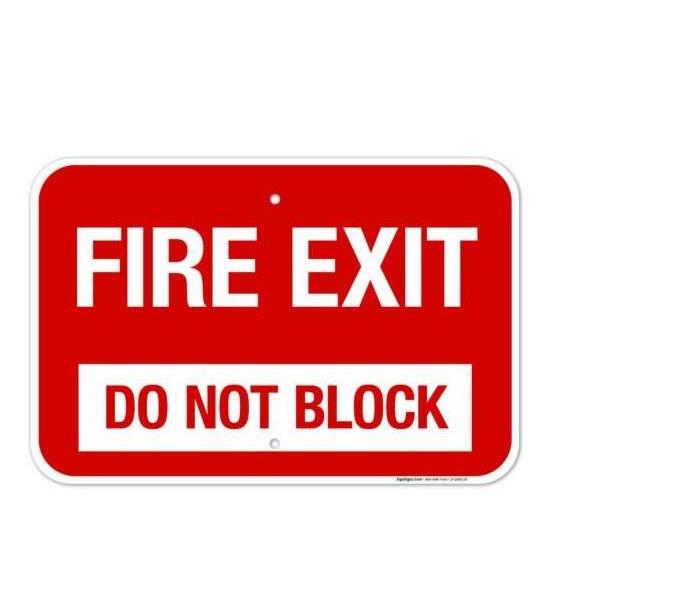 Have Fire Exit Posted and Marked
Have Fire Exit Posted and Marked
Most fires attended by fire rescue is in non-residential workplaces. Some common causes of fire in the workplace are faulty equipment, clutter, human error, and combustible materials on site. Arson makes up a large percentage of the fires on business premises.
Teaching your employees what to look for and steps to follow can create a safe environment. Listed below are steps for employees to follow and practice to keep them in control in case of a fire outbreak. 1. Have your employees get organized. Clutter can contribute to fires and block exits.
- Make sure there is a designated area for employees to smoke. Smoking should never be done in or around chemical staging area.
- Make sure all equipment is maintained and any faulty wiring is reported
- Make sure all chemicals are stored properly with adequate ventilation
- Make sure all employees know where the exits are. Have each exit posted and marked.
- Employees should have a list of emergency contacts and their phone numbers. Have the numbers to the business, address, and floor plan readily available.
Prevention is always better, and risk can be greatly reduced by following and maintaining safety measures. Keep your business and employees safe by staying organized, maintaining equipment, storing chemicals properly, know exit route, and keeping a list of all emergency contacts.
Fire Tools
8/9/2022 (Permalink)
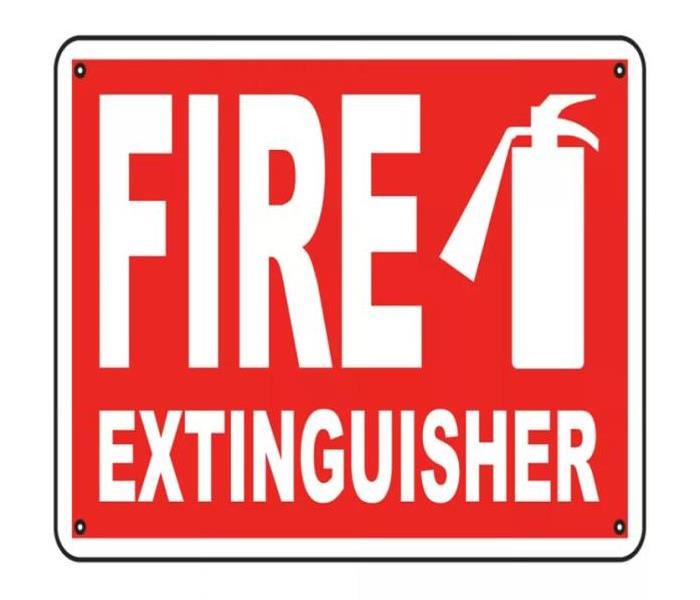 Fire Safety Tools
Fire Safety Tools
Fire Safety Tools
When it comes to a fire in your home minutes count. When prepared you can keep your family safe. Having the proper tools is a way to be prepared. Below are tools that can be used in your home to help prevent fires and be alerted of a fire outbreak:
- Smoke and Fire alarms play a vital role in preventing death and injury
- Fire extinguishers can put out small fires and save lives and property
- Properly installed sprinkler system can reduce the flames and smoke during a fire
- Carbon Monoxide alarms should be placed in homes with detached garages and burning appliances. This is an odorless gas that is referred to as the invisible killer
- Flame retardants work to inhibit a fire. They are one of the most effective ways to slow ignition
When faced with fire or smoke damage, SERVPRO of the Quad Cities is your trusted leader in fire damage repair and restoration. We are dedicated to responding immediately to your damage emergency. Our specialists are committed to providing superior service while restoring your property back to pre-fire condition.
Risk of Electrical Fire
8/4/2022 (Permalink)
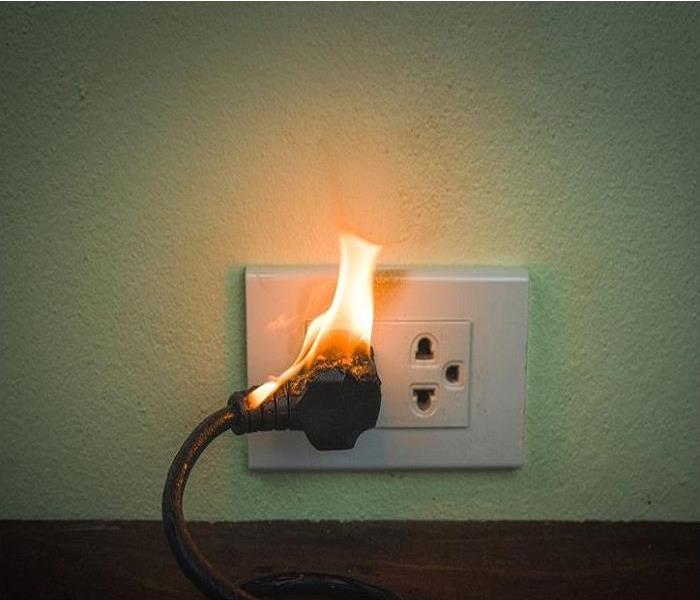 Risk of Electrical Fire
Risk of Electrical Fire
Electrical problems are a major cause of fires. There is plenty of energy in an electrical appliance to cause a fire. If not properly maintained and installed, they can be responsible for fire and injury.
Electrical fires can be divided into three categories:
- Fires started by worn out electrical equipment. Examples include dirty electric motors and deteriorated insulation.
- Improper use of approved equipment. Examples include overloaded cords and improper use of heating appliances.
- Accidental occurrence or operator error. Examples are lamps, heating equipment left on, and clothes left in contact with heating devices.
Inspect your home for older pieces of equipment and cords that may be damaged or frayed. Remember that when using an extension cord it should only be a temporary solution. Remember that multiple plug adaptors can cause an overload to the circuits.
Consider all the risk factors and maintain proper use of all electrical appliances. Be sure to keep combustible material away from heating sources. Following guidelines and taking safety precautions can greatly reduce you risk of electrical fires.
As a locally owned and operated business, SERVPRO of The Quad Cities is close by and ready to respond to your smoke or fire damage emergency. Have Questions about Fire, Smoke, or Soot Damage? Call us today at 256-383-4470.
Preventing Trash Fires
8/4/2022 (Permalink)
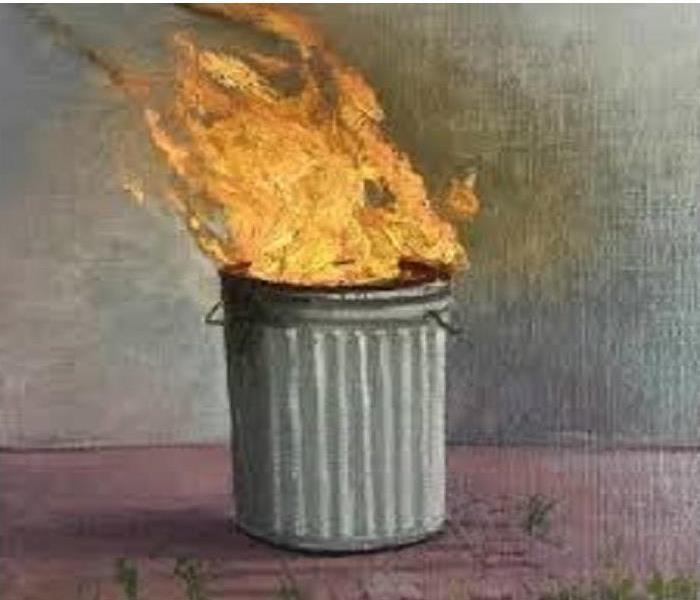 Prevent Trash Fires
Prevent Trash Fires
Help Prevent Trash Fires
Anything that is not recyclable that is put in the trash can be a fire hazard. Some items are more susceptible to causing a fire when not properly disposed of.
Rechargeable Batteries: car batteries, camera batteries, cell phone batteries and any similar batteries are a fire hazard
Flammable and Combustible Liquids: gasoline, oil-based paints and kerosene carry fumes that can easily ignite.
Household Chemicals: These chemicals can mix and cause fires. Chemicals can include ammonia, paint thinner and bleach. When the liquid has been used, rinse out the container before placing in the trash.
Ashes and Coals: Misjudgment of how long it takes for coals and ashes to burn out can lead to a fire. It is best to leave in the firepit or grill for 2 days to allow cooling off.
Play your part by recycling and properly disposing of flammable and combustible materials while preventing trash fires.
Space Heaters and Safety
12/14/2021 (Permalink)
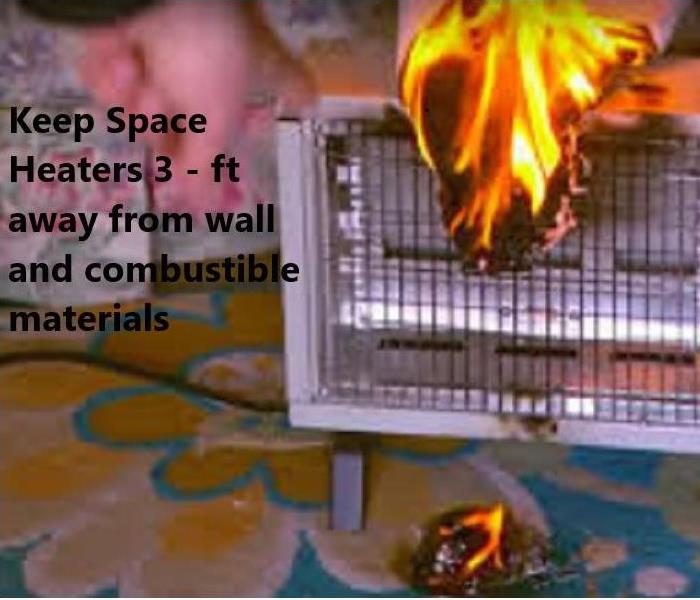 Space Heaters and Fire Safety Precautions
Space Heaters and Fire Safety Precautions
Space heater fires account for almost 50 percent of home heating fires. In mere minutes blankets, nearby furniture and any other flammable items can catch on fire if near a space heater. Most fire safety specialists suggest heating up a room for two to three hours before you sleep and then turning it off.
Space heaters are only safe to place on a solid surface floor such as wood, laminate, vinyl, or tile. Never place a space heater on top of an area rug. They can trap heat and ignite if the area gets too hot. Do not use an extension cord or power strip due to them overheating and resulting in a fire. Place space heaters directly into a wall outlet.
Remember that space heaters are typically used to supplement a main heating source. This helps when heating one main room instead of an entire home, especially for those that are cold sensitive. When looking to purchase a space heater be sure it has a guard around the heating element. This will help with kids and pets from getting burned. You can purchase one with a safety switch that will automatically turn the heater off if accidentally turned over. Thermostat controlled for saving energy is another feature to consider.
Establish a 3-foot safety zone around the space heater. You should put 3 - feet away from walls, and make sure all combustible materials are at least 3 feet away as well. Never leave running space heater unattended. Be sure to turn off and unplug when leaving the room or going to sleep. Teach children that parts of the heater can become extremely hot, and they need to stay away.
Practice safety! Do a routine check to determine whether the heater plug, cord, or wall outlet is getting hot. Limit the number of appliances running at the same time as to avoid a circuit overload. Before using your space heater read the manual and follow all manufacturer's instructions. If lost, you can locate on-line under the make and model.
Practicing safety will go a long way. You can keep your home, kids, and pets safe while staying warm. Follow simple rules and teach your children the risk of fires and what to do in case of a fire. SERVPRO of the Quad Cities wishing you a safe, warm, and wonderful winter season.
Holiday Fire Safety
11/29/2021 (Permalink)
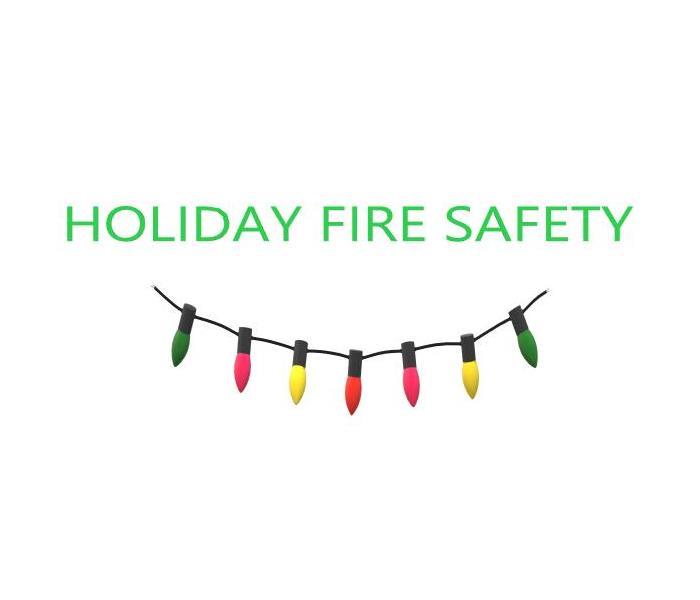 Practice Holiday Fire Safety
Practice Holiday Fire Safety
We are entering the five-week period of elevated fire hazards. Thanksgiving Day starts the five week hazard and goes to New Year’s Day. The top 3 things that cause fires during the holidays are cooking, holiday decorations, and candles. Thanksgiving, Christmas Eve and Christmas are the top days for cooking fires. The top days for candle fires are between Christmas and New Year’s Day. An average of 7,400 fires a year are caused by candles. Holiday decorations caused an average of 790 home fires per year. Fires started by decorations usually start because they are placed too close to a fire source.
Remember to never put water on a grease fire. When using a fryer be sure to follow all manufacturer’s instructions and use outdoors. Using basic safety tips when cooking inside or outside can reduce the risk of a fire or injury. Never overload outlets, power strips, or allow cords to dangle off surfaces.
If you have children in the home, you will need to decorate with them in mind. Small ornaments that are placed on lower branches of tress can cause a choking hazard. Be sure to keep the lights out of their reach. Place exposed cords under a rug to reduce tripping hazards
During the holidays when having overnight guests, you should ensure they are familiar with the family fire escape plan. Have your SERVPRO of the Quad Cities contact information for any emergency fire mitigation needs. Our service is available 24/7 including holidays to ensure your emergency needs are immediately taken care of. The sooner your mitigation begins the less out of pocket cost and more structural damage that can occur. When a fire must be put out by the fire department and water damage has occurred, it only takes 48 hours dwell time to turn into category 2 gray water. Special steps will be necessary to return the structure to a pre loss condition. Category 3 water damage is considered to carry pathogenic agents, grossly unsanitary and will require many steps to return to a livable condition. Our technicians respond immediately to access the damage and start mitigation before further damage occurs. Trust your local SERVPRO team to provide exceptional customer service by keeping you informed as well as your insurance carrier with mitigation progress.
We at SERVPRO of the Quad Cities wish you and your Family the best of holidays during the next 5 weeks. Remember to practice fire safety and your fire emergency plan with your family and guest.
Smoke Webs
11/10/2021 (Permalink)
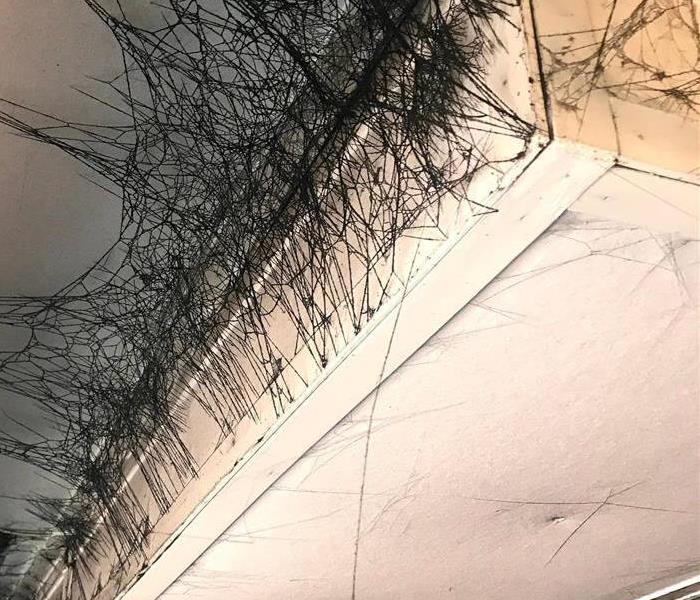 Smoke Webs form when the air flow in the fire slows down
Smoke Webs form when the air flow in the fire slows down
Smoke webs can suddenly appear when you have a fire in your home. The webs are formed as the fire consumes oxygen and airborne soot particles begin to bond together. The webs will rise with heat and cling together. They can be found on light fixtures, corners of the ceiling and anywhere where the air flow in the fire slows down.
Hot air from the fire rises and goes up to the ceiling and expands out when it gets to the corner of a wall. When this happens, the soot goes down and links together like a magnet causing an entwined web. Smoke and soot can also make its way into wall cavities and the attic.
The soot is formed from the burning of the structure material to the contents of your home. The particles from the burnt items can settle through- out the home. SERVPRO of the Quad Cites is highly trained in Fire Restoration. We have the necessary equipment and products to eliminate smoke damage. Our team works to remove smoke webs and restore your home back to living conditions. We specialize in contents cleaning for salvageable items and odor in your home from fires. We offer move out and move back services while keeping your contents in our maintained warehouse. Your items can be stored and cleaned giving you the peace of mind that they will be returned once your home is restored.
There is no substitute for training and experience. As fire and water damage specialists, our business is built upon fire and water restoration expertise. We have the knowledge and the specialized equipment to get your property back to pre-fire condition. SERVPRO of the Quad Cites is your local fire restoration company offering 24/7 emergency services. Peace of mind and working directly with your insurance company to get your mitigation started immediately to avoid further damage and excess cost.
Kitchen Fires
8/25/2021 (Permalink)
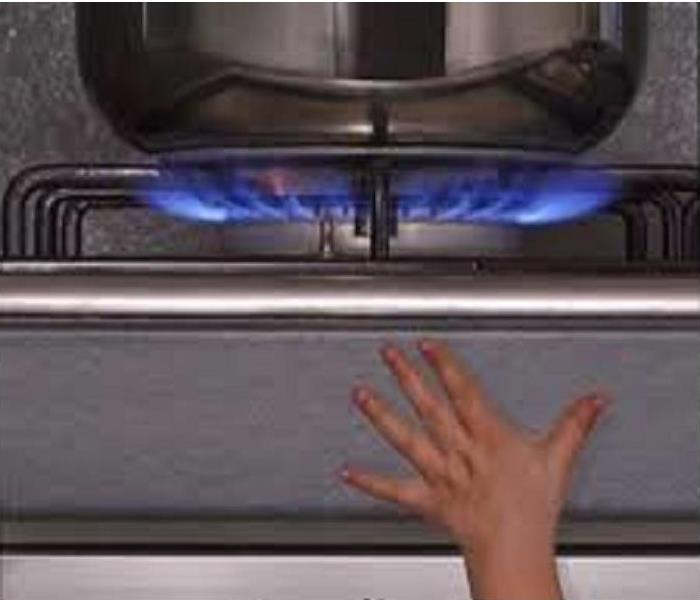 Kitchen Safety for Children
Kitchen Safety for Children
Home fires are most likely to start in the kitchen than any room in the house. The second leading cause of fires inside the home are from wood stoves and fireplaces. Multitasking while cooking is the biggest reason fires start in the kitchen. One third of fires are caused by not paying attention to food on the stove. Cooking oil or grease can easily catch fire if it gets too hot. Ranges and cook tops account for 58% of fires and ovens account for 16%. Microwaves are the leading cause of scald burn injuries. Hot pans and the hot stove with hot liquids or steam accounted for 55% of burns in children. Trying to fight a kitchen fire yourself can lead to injury and making the matter worse.
Keep your family safe by providing safety tips to prevent fires and burns. Have a kid free zone of at least 3 feet around the stove and hot objects. Children need to be aware of the dangers of cooking and being too close to hot objects. Keep hot objects away from the edges of tables and counters due to small children reaching for food.
Keep a clutter free area when cooking to reduce the chance of flammable material setting a fire. Items to keep away from the stove would include dish towels, potholders, and paper towels. When distracted and having to leave the kitchen it is best to turn the stove off. Two of every five home fires start in the kitchen and could have been prevented.
When you have experienced a kitchen fire from a food source you will have soot and odor through out the home. To remove soot and smoke from walls, furniture, and floors, contact your local SERVPRO of the Quad Cities. Since each smoke and fire damage situation is a little different, each one requires a unique solution tailored for the specific conditions. When various materials burn, the soot and residue they create differs greatly and requires a specific cleaning procedure. Listed below are tips on what not to do after a fire:
What NOT To Do After a Fire
- Don't attempt to wash any walls or painted surfaces or shampoo carpet or upholstery without contacting us.
- Don't attempt to clean any electrical appliances that may have been close to fire, heat, or water without consulting an authorized repair service.
- Don't use any canned or packaged food or beverages that may have been stored near the fire, heat, or water.
- Don't turn on ceiling fixtures if ceiling is wet. The wiring may be damaged.
- Don't send garments to an ordinary dry cleaner. Improper cleaning may set smoke odor.
Leave the cleaning and restoration needs to SERVPRO. There is no substitute for training and experience. As fire and water damage specialists, our business is built upon fire and water restoration expertise. We have the knowledge and the specialized equipment to get your property back to pre-fire condition.
Kids Fire Safety
8/20/2021 (Permalink)
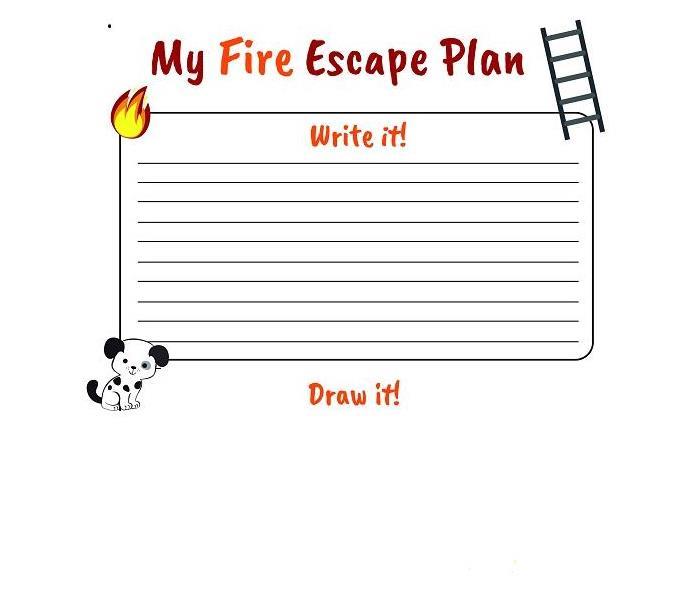 My fire escape plan, write it and draw it for kids
My fire escape plan, write it and draw it for kids
Sharing Fire Facts with your children can teach them the importance of Fire Safety and understand the risk and dangers of a fire. Teach your children what fire can be used for and what fire requires to burn. Listed below are some fun facts to share with your child:
Fires require fuel, oxygen, and heat to burn
Flames are the part of a fire which we can see, they can be different colors, depending on the substance which is burning
Fire is very dangerous to humans as it can easily burn or blister skin. It is important to take safety precautions when using fire
Fire extinguishers are often used to control fires by discharging water, foams, carbon dioxide, dry chemicals, or other substances
Scientists believe that humans began using fire to cook food in a controlled way around 1 million years ago
A candle flame typically burns at around 1000 degrees Celsius
Once your child has an understanding of fire teach them about ways to stay safe in case, they ever experience a fire emergency. It is important to regularly review fire safety so every household member will be prepared. Listed below are ways to practice safety and escape with your children:
Determine two ways out of every room in your home, if possible
Use a designated meeting space outside of your home and make sure each child knows to go there and wait for you
Practice opening windows
Use escape ladders
Touch door and check for het
Use your hands, not your eyes to get out of a darkened area
Out means Stay Out
Every year, kids of all ages start over 35,000 fires that hurt people and damage property. Teach your children to not play with fire sources. Talk about the fire safety with your children and practice twice a year your escape plan.
Lightning Strikes
8/19/2021 (Permalink)
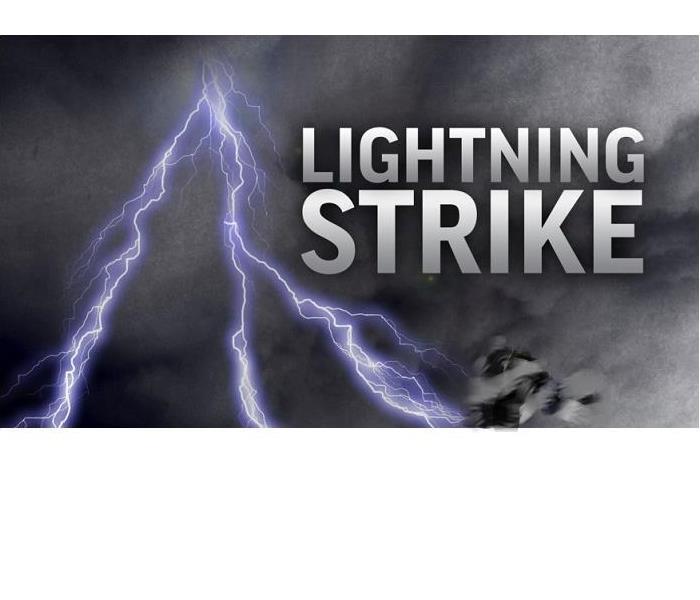 Lightning Strikes can reach 50,000 degrees!
Lightning Strikes can reach 50,000 degrees!
Late afternoons and evenings in June and August are the most common months to experience Lightning related fires. In addition to causing fires, lightning can be just as dangerous on its own. It is estimated that a lightning bolt’s temperature can reach 50,000 degrees. If your home is hit by lightning, you may not notice a fire caused by the strike immediately. Fires can hide inside the walls or in attic spaces. If you home has been struck by lightning all you local Fire Department right away. It is also advised to schedule an electrical diagnosis of your home’s wiring with a qualified electrical company.
The outside of your home may be protected but the appliances and technology items are at risk. Purchasing a power surge strip or a whole house surge device can protect the items at risk. Depending on the intensity of the strike the power surge strip can sometimes fail. The best form of protection for your appliances is to unplug them during a thunderstorm. Land line phones are at a high risk of being struck and if phone communication is needed it is best to use a cellphone. The first two items to consider unplugging during a storm is all computers and landline phones.
Safety for self is staying indoors away from electrical items, windows, water, and doors. Making sure each family member knows precautions to take to remain safe can save lives and property.
Storms don’t wait for normal business hours, and neither does SERVPRO of the Quad Cities. You can depend on an immediate response from our highly trained technicians, who are available 24 hours, seven days a week. As a leader in storm and water damage restoration, SERVPRO of The Quad Cities has the specialized training and expertise to restore your home back to its pre-storm condition. Our restoration process puts an emphasis on scientific drying techniques, progress monitoring and documentation.
If you have experienced storm damage, do not delay the process of restoration. Taking immediate action to property damage can save time and money where repairs are a concern. We work with all major insurance companies for a stress-free claims process. Don’t Delay, Call Today! Free estimates and excellent customer service from your locally owned SERVPRO Franchise.
Fire Safety with Disabilities
8/19/2021 (Permalink)
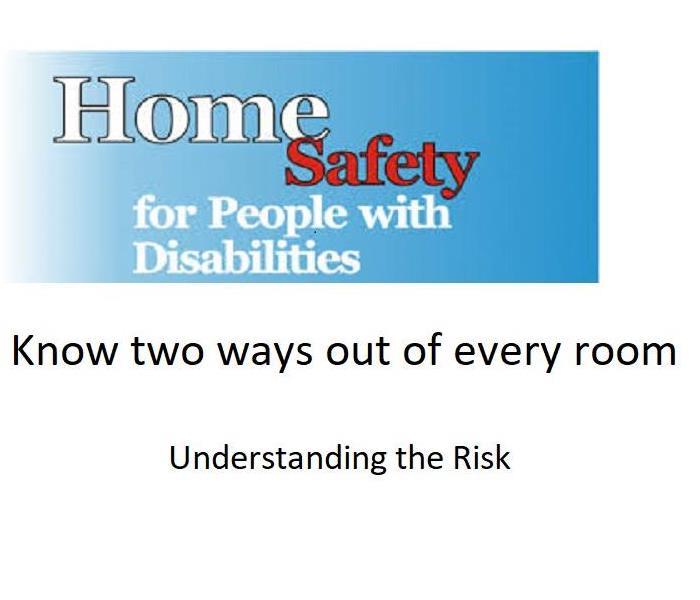 Know your risk and build your fire prevention plans
Know your risk and build your fire prevention plans
It is important to know your risk and build your fire prevention plans around your abilities. People with mobility, sight and hearing disabilities can significantly increase their chances of surviving a fire by practicing fire safety precautions. Approximately 3,500 Americans die and 18,300 are injured in fires each year. Using a Fire Safety Checklist can help protect yourself and your home from fire.
Depending on any physical limitations, individuals may require help from a caretaker, neighbor, or outside source. It is important to practice escape plans in case of a fire. Remember that in the event of a fire that every second counts.
People with mobility disabilities should be encouraged to have their bedroom on the ground floor and as close as possible to an exit. Listed below are more important steps to add to your Home Fire Safety Plan:
Know two ways out of every room
If you are deaf or hard of hearing, use smoke alarms with vibrating pad, flashing light or strobe light
Test your alarm monthly
Interconnect your alarms, so when one sounds, they all sound
Have smoke alarms inside bedrooms and outside sleeping areas
Be sure your street address is clearly marked and visible from the street
Creating a Fire Escape Plan is just as important as having a Fire Safety Plan. Listed below are tips on creating a safe escape:
Involve the assistance of a building manager, family member or a friend when practicing your fire escape
If you use a walker or wheelchair, check all exits to make sure they get through the doorways
When a fire occurs, do not waste any time saving property. Once out, stay out
Practice opening locked or barred doors and windows
Being on a ground floor and near an exit will make your escape easier
Never use an elevator
Millions of Americans live with mental and physical disabilities, and it is important to have a Fire Safety Checklist and Escape Plan. You can contact your local Fire Department to help with an escape plan and keep your needs on file.
Christmas Tree Safety
12/15/2020 (Permalink)
 Christmas Tree Hunting We Go!
Christmas Tree Hunting We Go!
The time of year to choose the perfect Tree. Creating memories, decorating and merry songs are a part of Christmas Traditions. With the fun and festivities safety is still something we all need to practice. Choose a tree with fresh, green needles that do not fall off when touched. Before placing the tree in the stand, you will need to cut off 2” from the base of the trunk. Placing the tree is very crucial when it comes to safety. Your tree should be three feet away from any heat source. Fireplaces, radiators, candles, heat vents and lights are heat sources the tree does not need to be nearby. Adding water to your tree daily will ensure it keeps moisture and does not dry out.
Lighting the tree is a delight and brings it to life. Be sure to replace any string lights with worn or broken cords or loose bulb connections. Connecting too many lights to one strand can be a fire hazard. Read manufacturer’s instructions for number of light strands that can be connected. Never use lit candles to decorate your tree. Always turn off Christmas tree lights before leaving home or going to bed.
More than one of every four home Christmas tree fires is caused by electrical problems. Christmas tree fires are not common but when they do happen it is serious. Practice safety and enjoy your tree for the Christmas Season. When the season has ended get rid of the tree. Dried out trees are a fire danger and should not be left in the home or garage. Check with your local community for recycling programs.
We at SERVPRO of the Quad Cities wish you and your Family a Merry Christmas. May your Christmas be Merry and Bright!
Bedroom Fires
11/30/2020 (Permalink)
 Bedroom Fire Safety Tips to prevent a Fire
Bedroom Fire Safety Tips to prevent a Fire
Bedrooms are the most common spot in the house for electrical fires to begin. These fires account for about 15% of residential fires. The death toll is greater in numbers from bedroom fires due to people being asleep.
These fires are often caused from faulty or overtaxed wiring or lighting that has malfunctioned. Bedroom fires also start with cords, space heaters, or electric blankets. Draperies and bedding to close to a heater source ignite quickly.
Steps can be taken to prevent a fire in your bedroom. Inspect the area and perform any maintenance that needs to be done on old or faulty wiring. Follow the steps below in keeping your bedroom safe from fire hazards:
- Quickly address any loose or otherwise unsafe-looking wall outlets.
- Replace extension cords, chargers, lighting cords, or other power cords as soon as they show signs of wear. If you can see the wires, it’s time for a replacement. You can have lighting shops rewire favorite lamps if the cord is worn out.
- Do not overload outlets by plugging in too many devices, power strips, or extension cords.
- Before you head into the cooler months and start up a cozy fire, have your chimney professionally cleaned.
- Keep combustibles, including draperies and upholstered furniture, at least three feet from the heat source.
- Invest in a fireplace screen to prevent embers from escaping.
- Never leave the fire unattended, and make sure it’s completely out before leaving the house.
- Use the recommended fuel for your heat source.
During the event of an unfortunate fire disaster, SERVPRO of the Quad Cities is your Local Fire Mitigation Experts. Our trained technicians are available 24/7 for your emergency needs. Working with our customers and your Insurance Carrier for complete customer satisfaction.
Kitchen Fires
11/13/2020 (Permalink)
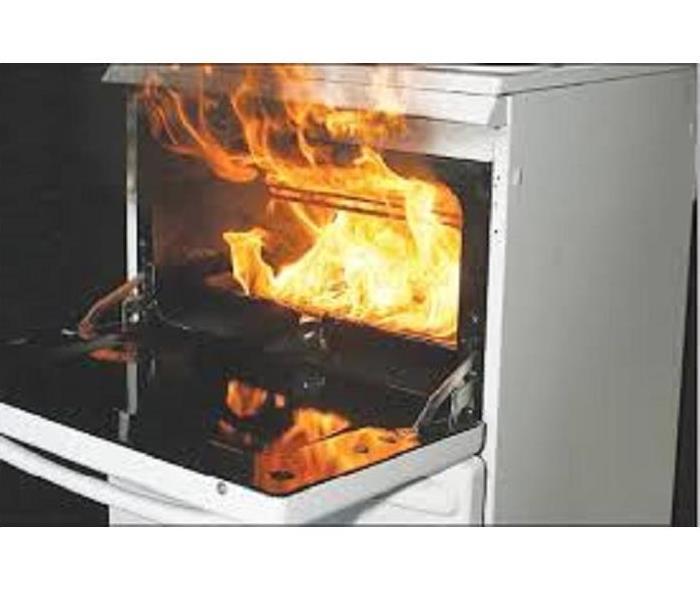 Unattended Cooking is a Fire Hazard
Unattended Cooking is a Fire Hazard
Of all fires reported in the U.S, yearly, 27% are fires that start in the home. These fires cause the most deaths related to fires. If you have an idea where fires are most likely to start, preparation and prevention measures can be taken.
The kitchen is the most common area in the house for fires to start. Unattended cooking is the leading cause of kitchen fires and fire related injuries. These fires can be prevented if someone is keeping an eye on the stove or oven. Never leave the stove unattended when cooking with high heat. Frying, boiling, or broiling need only seconds to form a small flame and get out of hand.
Simple steps like turning off the stove and other appliances when you are done cooking prevents a kitchen fire. Keep items as dish towels and hot pads off hot surfaces. If you ever have to step way form cooking, make sure to designate someone to oversee the process. If no one is available, turn off the appliance until your return.
Remember that water will only spread oil or grease and feed the flames. Keep a Class B Fire Extinguisher handy in your cooking area. When fires are extinguised there is usually soot and odor left behind. SERVPRO offers Fire Restoration services for smoke damage and soot on walls, ceilings and contents. If you have experienced a Kitchen Fire reach out to your local SERVPRO. We offer estimates and SERVPRO is a Preferred Vendor for many National and Local Insurance Companies. Call today and our trained technicians will arrive to clean and restore your home with as little disruption as possible. SERVPRO of the Quad Cites servicing our area 24/7.
Kitchen Fire Safety
8/26/2020 (Permalink)
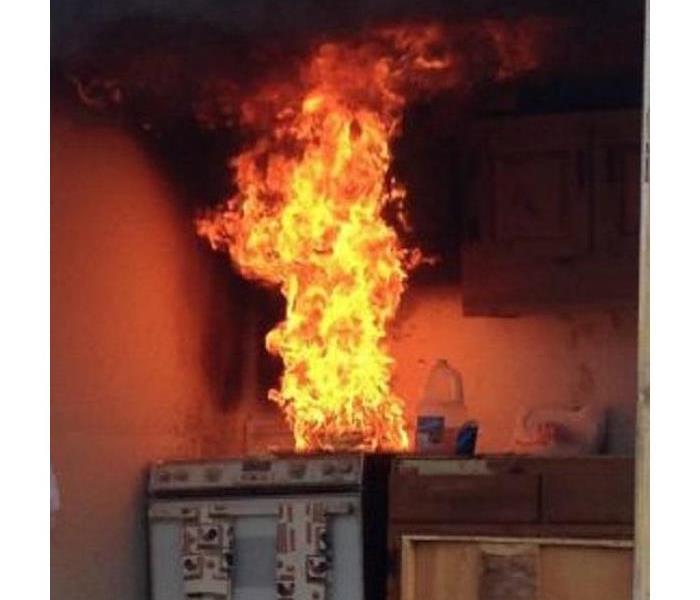 Kitchen fires can be prevented by following safety tips
Kitchen fires can be prevented by following safety tips
Cooking fires are the primary cause of home fires and home fire injuries. Two of every five home fires start in the kitchen while food is cooking. On average, they cause 44 percent of home fires, 15 percent of home fire deaths and 38 percent of home fire injuries each year. Homeowners can minimize fire risks by removing hazards and maintaining your kitchen. Never leave food that is cooking on the stove unattended. The food can become too hot resulting in a fire.
As a homeowner by making sure all appliances are serviced, cleaned and in good working condition is a preventive measure to reduce the chances of a kitchen fire. Appliances that are plugged in continue to draw electricity and any faulty wiring could pose a fire threat. Be sure to replace faulty equipment that is found before your next use.
Grease buildup is flammable and should be cleaned up after each use of the stove. Do not keep dish towels, paper towels or other flammable material near the stove when in use. Following safety procedures and never leave cooking food unattended can greatly reduce the chance of a grease or stove fire to start or spread.
If a kitchen fire starts take quick action to confine and keep from spreading. Never use water to put out a grease fire due to how water repels grease. Lids can be put on pans and pots to smother the fire. Use the fire extinguisher if it is not possible to put a lid on. If the fire can not be contained and is spreading immediately call 911 and remove yourself from the home.
Fires are devastating to your home and family. During this time homeowners need to know their concerns are being handled by professionals specialized in fire restoration. At SERVPRO our technicians are highly trained and have experience to quickly clean up and restore your home to pre-fire condition. They can also remove the smoke odor and deep clean soot from your upholstery and carpet. SERVPRO offers laundry and dry- cleaning service along with contents storage in our warehouse.
Visit our website to see helpful tips on how to protect yourself and your family during a fire. We are available 24/7 for your emergency service and a Preferred Vendor for Many National and Local Insurance Companies.
Pets and Fire Safety
8/21/2020 (Permalink)
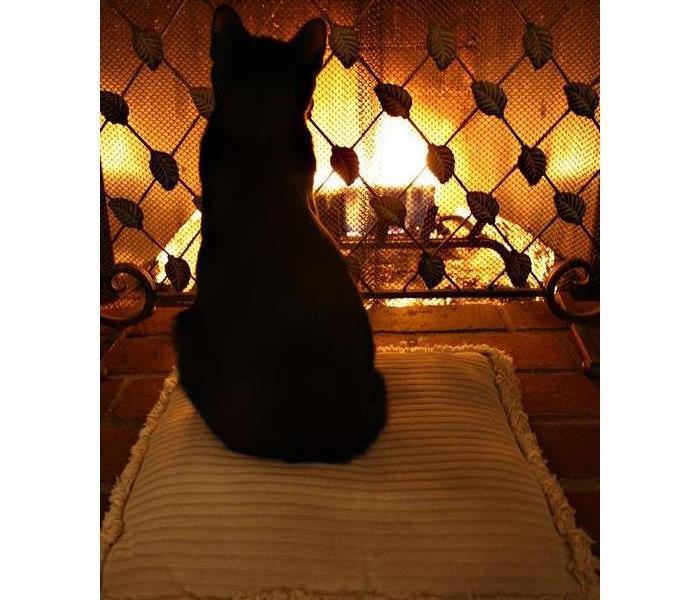 Your Pets and Fire Safety Tips
Your Pets and Fire Safety Tips
Household pets are responsible for over 1,000 house fires each year in the United States. We sometimes unknowingly set the stage for such unfortunate events to happen. It has been reported that at minimum 40,000 pets die each year in house fires. If a pet has access to any of the wiring or cables around the house, they can potentially start an electrical fire. One of the easiest ways to pet-proof a house from electrical hazards is to start by gathering all loose, exposed wires together with a twist tie so that they are not as tempting to play with. Additionally, keep location of electrical cords, outlets and heaters in mind when picking where to place your pet’s food and water bowls, beds, and crates. If your pets are already in their crates when emergency crews arrive, they can be more quickly and easily removed to safety.
Most fires are caused by pets knocking over candles or leaning against stove knobs. To avoid use child and pet-safe gates to keep them away from flames. Using heaters that turn off automatically when knocked over can prevent fires as well. Since flameless candles do not involve actual flames, there is no danger of your pet starting a house fire by knocking one over.
Educating yourself on pets and fire safety can save your life, pets, and your home. Taking simple steps to remove items within your dogs reach that can cause a fire hazard is the first step. Before bringing your new addition, home make sure all electrical wiring has been secured. Make sure you select a safe place to put your pets’ crate or bedding. Do not place near any open flames as fireplaces or heaters. When using candles place them out of your pet’s reach. Remember your pets are curious and will seek out anything to chew and play with.
Your local SERVPRO is always here to help in any fire or smoke damage you may have experienced. We are dedicated to responding to your fire emergency immediately.
Fireblocking to Firestopping
8/20/2020 (Permalink)
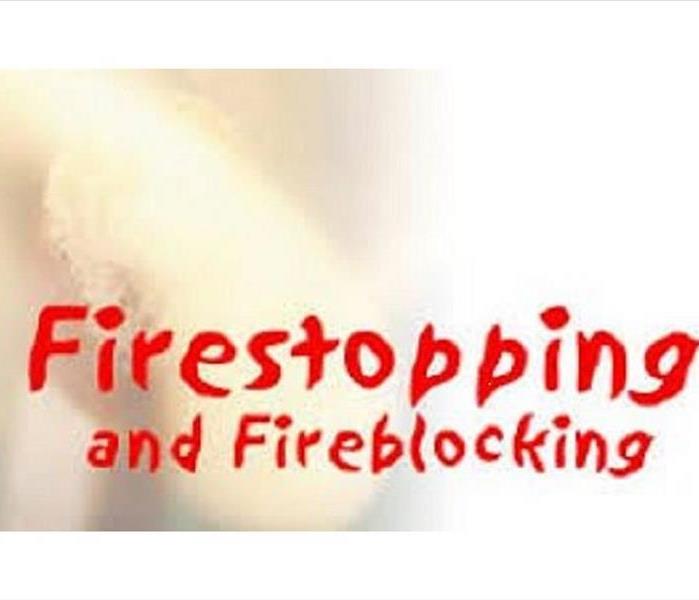 Fireblocking to stop the spread to fire
Fireblocking to stop the spread to fire
Some home owners don’t even know the fire danger their home can pose. Some officials have reported entire homes go up in flames within 20 minutes once the fire enters the walls of a balloon-frame structure. If a fire has a lot of headway, it is a no-win situation for the fire suppression personnel.
When there are holes and gaps in the walls and ceiling it provides airflow that feeds a fire. When these gaps and holes are sealed it slows the fire and could potentially stop it from spreading. Fire departments in the United States respond to more than 350,000 home structure fires each year. Following guidelines set forth for fireblocks can keep a fire from spreading to concealed places in your home.
This method of fireblocking works by dividing framing cavities into separate compartments, slowing the passage of flames and combustion air. Materials approved for fire blocking are just common building materials.
- 2-by (1-1/2 in. thick) lumber.
- Two layers of 1-by lumber.
- One layer of 3/4-in. plywood with 3/4-in. plywood covering any seams.
- One layer of 3/4-in. particleboard with 3/4-in. particleboard covering any seams.
- 1/2-in. drywall.
- 1/4-in. cement board.
- Batts or blankets of mineral wool or fiberglass insulation secured in place.
- Cellulose insulation installed as tested for the specific application.
- Approved spray foams and caulks.
Code requirements for adding fire blocking and draft stopping apply to new construction. When upgrades are made to an existing structure; fire blocking will need to be added when adding additions, finishing a basement, or running pipes and wires.
Home owners should have multiple exit routes and plans to get out from levels of floors. Safety ladders are a good advice for any home. It is also recommended that residents change the batteries in smoke detectors when they change the clocks every spring and fall.
If you have experienced smoke or fire damage reach out to your local SERVPRO franchise. When you have a smoke or fire damage emergency, your local SERVPRO franchise is already nearby and ready to help. We take pride in being a part of our community and want to do our part in making it the best it can be.
Fireblocking to Firestopping
8/20/2020 (Permalink)
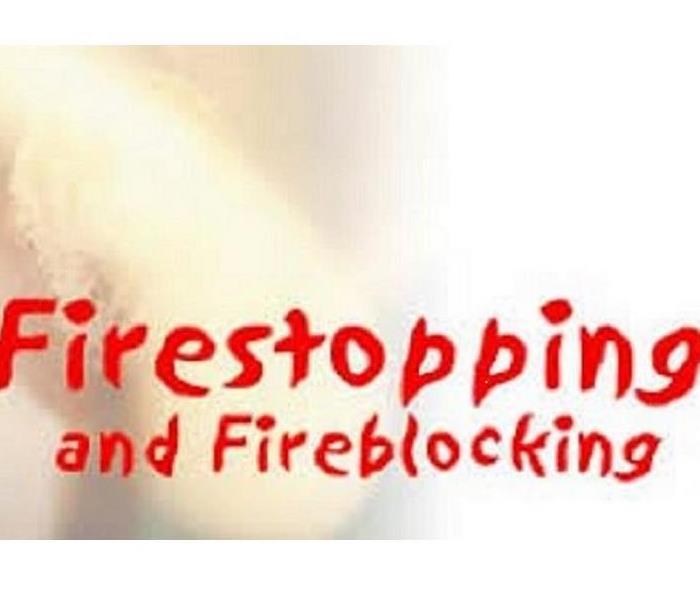 Fireblocking to stop the spread to fire
Fireblocking to stop the spread to fire
Some home owners don’t even know the fire danger their home can pose. Some officials have reported entire homes go up in flames within 20 minutes once the fire enters the walls of a balloon-frame structure. If a fire has a lot of headway, it is a no-win situation for the fire suppression personnel.
When there are holes and gaps in the walls and ceiling it provides airflow that feeds a fire. When these gaps and holes are sealed it slows the fire and could potentially stop it from spreading. Fire departments in the United States respond to more than 350,000 home structure fires each year. Following guidelines set forth for fireblocks can keep a fire from spreading to concealed places in your home.
This method of fireblocking works by dividing framing cavities into separate compartments, slowing the passage of flames and combustion air. Materials approved for fire blocking are just common building materials.
- 2-by (1-1/2 in. thick) lumber.
- Two layers of 1-by lumber.
- One layer of 3/4-in. plywood with 3/4-in. plywood covering any seams.
- One layer of 3/4-in. particleboard with 3/4-in. particleboard covering any seams.
- 1/2-in. drywall.
- 1/4-in. cement board.
- Batts or blankets of mineral wool or fiberglass insulation secured in place.
- Cellulose insulation installed as tested for the specific application.
- Approved spray foams and caulks.
Code requirements for adding fire blocking and draft stopping apply to new construction. When upgrades are made to an existing structure; fire blocking will need to be added when adding additions, finishing a basement, or running pipes and wires.
Home owners should have multiple exit routes and plans to get out from levels of floors. Safety ladders are a good advice for any home. It is also recommended that residents change the batteries in smoke detectors when they change the clocks every spring and fall.
If you have experienced smoke or fire damage reach out to your local SERVPRO franchise. When you have a smoke or fire damage emergency, your local SERVPRO franchise is already nearby and ready to help. We take pride in being a part of our community and want to do our part in making it the best it can be.
Kids and Fire Safety
12/16/2019 (Permalink)
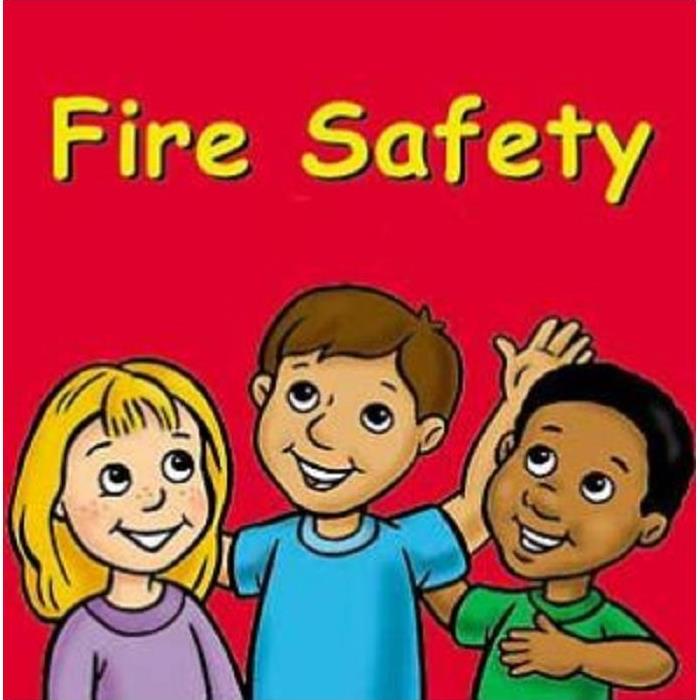 Kids and Fire Safety
Kids and Fire Safety
Fire Safety and Kids
It is important to regularly review fire safety with kids, so they will be prepared in the event of a fire emergency. Your childcare provider, teachers and parents should work together to teach children of all ages about fire safety.
Talk to Children about Smoke Detectors and there importance
Discuss why smoke detectors are installed, how they work and the noise they make. Children need to know the sound the detector makes is associated with a fire. Be sure to change the batteries regularly to ensure the alarm is not going off due to low battery and causing panic in children. Firefighters recommend changing your smoke detectors’ batteries every time you turn your clocks ahead or back for Daylight Saving Time.
Plan Escape Routes
If possible there needs to be two ways planned out of every room in your home. Usually, this means a door and a window. Evaluate your home and establish a plan especially for rooms that don’t have windows like offices and some media rooms. There should be a designated meeting space outside of your home for all members to meet and wait for you. Make sure your children know to go outside and not to hide out of fear.
Practice Opening Windows
In the event of an emergency, older children should be able to complete the task of opening windows on their own. Make sure all window screens can be removed quickly, windows are not stuck closed and security bars can be opened.
Use Escape Ladders
Escape ladders should be installed near second floor windows. Children should practice using them. Practice a first floor window exit with younger children to give them some idea of what to expect.
Touch Door and Check for Heat
Instruct kids how to check doors to see if they are hot, and if so, how to find another way out. Fire safety for children includes having them find a towel to use for handling, touching or grabbing items to avoid burns and to also use the towel or cover to protect their faces and cover their mouth. If both exits of a room are blocked, kids should get as low as possible. Lie on the ground, near the bed if possible that is where firefighters will look for them.
Use Your Hands, Not Your Eyes
Children should practice feeling their way out of the home in the dark or with their eyes closed. This can be turned into a game by blindfolding your child and asking them to feel their way to a designated area. Daycares and schools can set up an obstacle course to reach designated end points. Using fun activities can teach children how to escape.
Stop, Drop and Roll
Teach children what to do in the event that their clothes catch fire. Make sure they understand “stop, drop and roll”. Act it out for them and have them practice with you.
Out Means Stay Out
Teach children that once they are out of a burning house or building, they must go to the designated meeting place and never, ever venture back in. If a family member or a pet is missing, they should inform a firefighter or adult. There are too many tragedies where an individual who has gotten out safely ventures back into the home or building.
Practice Monthly
Practice your escape plan at least twice a year; monthly is even better. Just like schools, child care centers and homes should also practice fire drills.
Having your children well prepared can save lives. Knowing what to do keeps them from panicking and keeping a mind set of getting out safely. Remember that every household member needs to meet in the designated area that was established during your practice drill. Create a chart with a layout of your home and list all exits, doors, windows and fire escapes. Label rooms and add your meeting point. Post your chart where it is visible to all on a daily basis.
Live Christmas Tree and Safety
11/26/2019 (Permalink)
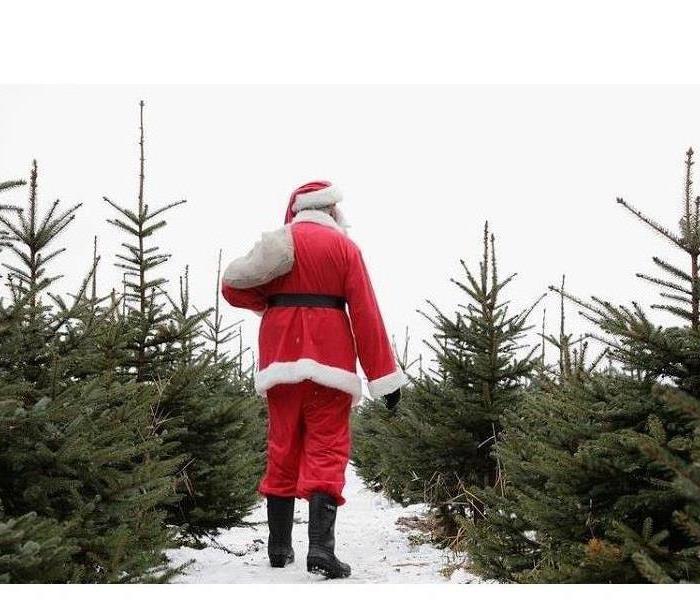 Even Santa looks for the perfect Christmas Tree
Even Santa looks for the perfect Christmas Tree
Fire Safety during the Holidays when a Real Tree decks the halls of your home…
When showcasing a live tree in your home, the combination of tree dryness, electrical malfunction with lights and poorly located heating sources can make for a deadly combination. The safest option is to purchase a live tree and cut it down yourself. If a pre-cut tree is purchased make sure you check the trunk for stickiness and the limbs for flexibility. If the limbs break off easily it is not a good tree.
Always place your tree away from heat sources like fireplaces, radiators, candles, heat vents or lights, and keep the tree base filled with water to avoid a dry out. Your tree needs to be a minimum of 3 feet from heat sources. Christmas trees alone result in 13 million dollars, annually, in property damage. Remember you tree will need care by providing water and not allowing the base to go dry. Check the base frequently, especially if you have pets that like to visit the tree for a drink.
Lighting the tree is not always the easiest or most volunteered for project, but what a beautiful sight it is once they are strung. To keep your live tree safe and fire proof make sure to not plug more than 3 strands of lights into each other. Use a power strip to add additional strands. Be sure to turn the lights off when going to bed or leaving the house.
Keep all of your holiday candles away from your tree. Use electronic candles and non-flammable decorations. If you have a fire place in your home use a fire screen and make sure the embers are extinguished before going to bed.
When you home is filled with the joy pets bring there are precautions that need to be taken to keep them safe. Make sure the tree can not be toppled over by the mischief pet pawing at the delicate ornaments that look ever so tasteful. Loop twine or fishing line around the trunk and tie to a screw in the wall. If there are cords on the floor they can be duct taped down to keep your pets from chewing on them. Keep the needles cleaned up off the floor to keep your pets from licking them and possibly ingesting insecticides or flame retardants.
What joy a live Christmas tree can bring and a tradition that has been long practiced. With a few safety precautions to follow all can enjoy through out the Christmas holiday. Let the tree decorating begin!
Types of Fire Extinguisher
11/18/2019 (Permalink)
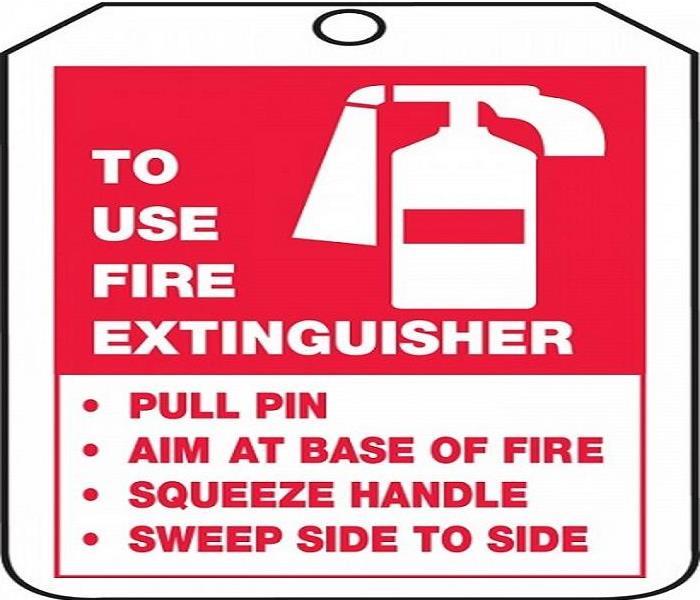 Remember PASS when using your fire extinguisher
Remember PASS when using your fire extinguisher
There are 5 main fire extinguisher types – Foam, Water, CO2, Dry Powder and Wet Chemical. To meet current regulations you should have the right type for your premises.
The fire risk from the class of fire will determine what type of fire extinguisher will be needed. You will also need to make sure you have the right size and weight. There are different versions of both the Water and Dry Powder fire extinguisher meaning there are 8 types to choose from.
- Water
- Water Mist
- Water Spray
- Foam
- Dry Powder – Standard
- Dry Powder – Specialist
- Carbon Dioxide (CO2)
- Wet Chemical
Water extinguishers are the most common type for Class A fire risk. They are used for Organic materials such as paper, cardboard, fabrics, textiles, wood and coal. They are not to be used on fires involving electrical, kitchen fires, flammable gas or liquids. Water extinguishers work by having a cooling effect on the fuel, causing it to burn much more slowly until the flames are eventually extinguished. Water spray extinguishers are equipped with a spray nozzle meaning a greater surface area can be covered more quickly. Water mist extinguishers release microscopic water particles. The particles suffocate the fire and create a wall of mist between the fire and the person using the extinguisher.
Foam extinguishers are most common for Class B fires but can work on Class A fires because they are water based. They can extinguish the same type of fires as the water extinguisher plus flammable liquids, like paint and petrol. They are not to be used on kitchen fires, fires involving electrical equipment nor flammable metals. Most buildings need either water or foam extinguishers.
Dry Powder extinguishers are also called ABC extinguishers because they can take care of Class A, B and C fires. They are not recommended in enclosed spaces due to the residue being difficult to clean up and easily inhaled. They are not recommended for use on fires involving cooking oil, electrical equipment over 1000v, in offices or residential properties. Specialist Dry Powder extinguishers are used only on flammable metals, such as titanium and magnesium. Dry Powder smothers a fire by forming a barrier between the fuel and the source of oxygen.
CO2 extinguishers are predominantly used for electrical fire risks and are usually the main fire extinguisher type provided in computer server rooms. They can also put out Class B fires involving flammable liquids such as paint and petroleum. They are not to be sued on kitchen fires, combustible materials like paper, wood or textiles nor flammable metals. CO2 extinguishers suffocate fires by displacing the oxygen the fire needs to burn. All work vehicles should carry a smaller 2kg CO2 extinguisher
Wet Chemical extinguishers are designed for use on Class F fires, involving cooking oils and fats. They can also be used on Class A fires. They are not to be used on flammable liquid or gas fires, electrical fires or flammable metals. Wet Chemical extinguishers work by creating a layer of foam on the surface of the burning oil or fat, preventing oxygen from fuelling the fire any further. The spray also has a cooling effect.
Be sure to place your fire extinguisher near the source of fire risk. Safety is first and being trained in proper use can reduce injuries. If the fire is out of control you need to use your evacuation plan. Close doors behind you and always pay attention.
Creating a Fireproof Workplace
8/26/2019 (Permalink)
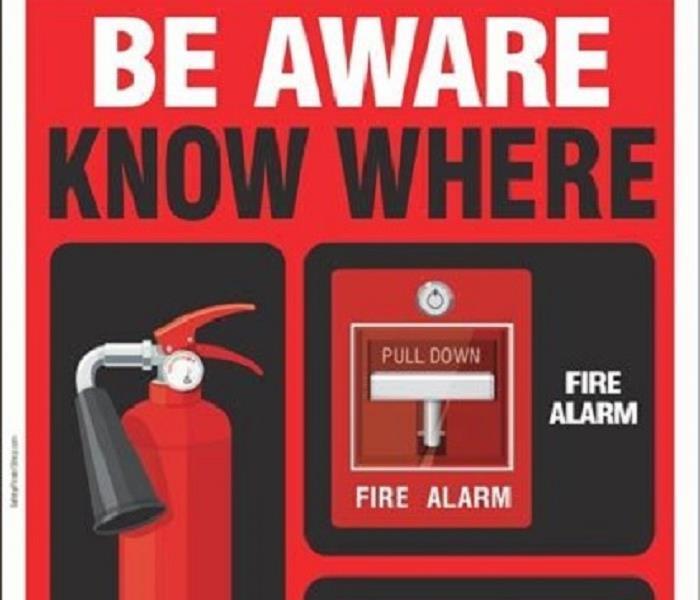 Fire Safety at the Workplace
Fire Safety at the Workplace
Creating a Fireproof Workplace
Creating a safety plan, securing your premises, installing sprinklers and fire extinguishers, and developing and practicing an evacuation plan all lead to a safer workplace. Employers should train workers about fire hazards in the workplace and about what to do in a fire emergency. If you expect your workers to use portable fire extinguishers, you must provide hands-on training in using this equipment.. Fireproofing an office should be a top priority.
Fire can severely impact productivity, ravage inventory, and cause very costly infrastructure damage. Claims for injuries and death can lead to higher premiums, and sometimes lawsuits. The following practices can reduce fire hazards in the workplace and reduce the likelihood of claims.
- Train employees to look for signs of hazards
- Store paper and cardboard in a proper area
- Oil, grease and solvents should be stored in a fire resistant container and removed from the premises as soon as possible
- Make sure all flammable liquids have lids and are covered when not in use
- Establish a strict smoking policy and enforce it
- Train employees on fire response and have fire extinguishers in designated areas
A business that uses vehicles for delivery and hauling equipment should make sure employees are trained properly on refueling.
- Refuel in a safe area where there are no sparks or cigarette smoking allowed
- Store and transport fuel in a Department of Transportation approved container
- Refill containers on the ground and not in the back of a vehicle
- Do no refill vehicles or equipment while running
- Ground yourself before you start refueling to prevent static buildup
Using electrical cords improperly is a work place hazard. We tend to overload when trying to get everything where we want it. Remember that electrical cords that are rated for indoor use are not appropriate for outside. The cold and heat can compromise the cord. Cords should not be ran under doorways and through windows. Shutting the doors and windows can squeeze the insulating jacket and cause sparks.
Controlling a hazard at its source is the best form of protection. Every worker plays a role in fire safety. Recognize and resolve any hazards you may notice.
How to Spot Electrical Problems in Your Home
8/23/2019 (Permalink)
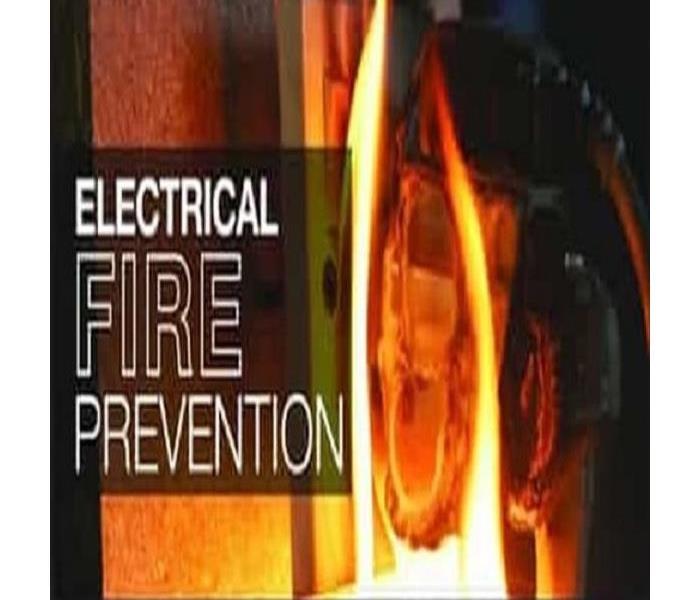 Preventing Electrical Fires in Your Home
Preventing Electrical Fires in Your Home
How to Spot Electrical Problems in Your Home
Most Electrical Fires are caused by faulty electrical outlets and old, outdated appliances. Other fires are started by faults in appliance cords, receptacles and switches. A worn or frayed cord can send heat onto combustible surfaces like floors, curtains, and rugs that can start a fire. There are signs to look for and smells that will let you know if your home is in danger of an electrical fire. If you notice any of the signs below take safety precautions to locate the source:
- Circuit breaker keeps tripping.
- Burnt smell with no identifiable source. (If you smell something burning and can't
- find the source, call the fire department).
- Several discolored or charred outlets and switches.
- You have old outdated wiring.
Hidden Dangers:
There are other electrical fire dangers in your home that, while they may not be as obvious, are no less dangerous.
Old Wiring – if the home is over 50 yeas old
Aluminum Wiring - houses built in the 1960’s and early 1970’s
Arc Faults - when electrical current veers off its intended path
Counterfeit Electrical Products – buy electrical products only form reputable retailers
Extinguishing an Electrical Fire
Electrical fires are tricky to put out. If you douse them with water, you run the risk of electrocution, and not all chemical fire suppressants will extinguish them completely. To be safe, make sure your household fire extinguisher is rated A-B-C, which indicates that it is effective against fires involving ordinary combustible materials, flammable liquids, and electrical equipment.
Prevent House Fires by Cleaning out Dryer Vents
8/21/2019 (Permalink)
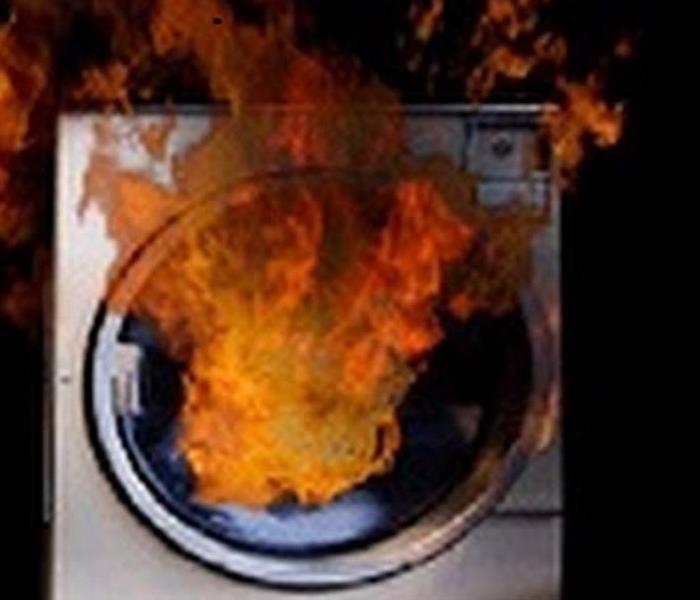 Preventing Fire Damage from Clogged Dryer Vents
Preventing Fire Damage from Clogged Dryer Vents
One of the leading causes of a house fire is an appliance we look at as harmless. Lint and other debris can build up in your dryer hose and vent duct, reducing air flow, backing up exhaust gases and eventually creating a fire. The National Fire Protection Association reports nearly 17,000 home clothes dryer fires each year. These clothes dryer fires cause around 51 deaths, 380 injuries, and $236 million in property loss. 34% of dryer fires are due to not cleaning the dryer. Overloading your dryer is as much a big deal due to excessive lent that causes poor ventilation. When there is no where for the excessive lent to go it can cause overheating of the dryer which can turn into a fire hazard. Dryer vent ducts should be inspected at least once a year to reduce the risk of fires and carbon monoxide poisoning.
When a dryer becomes clogged it gives off signs that we need to pay attention to and resolve. Acknowledging these signs immediately can reduce the chances of severely clogged ducts and a potential fire hazard. Below is a list of things to look for when determining if your dryer hose and vent duct could be clogged:
- A musty odor is discovered in the clothing following the drying cycle
- Clothes seem unusually hot to the touch
- Excessive heat is noticed in the room in which the washer and dryer are operated
- The dryer vent hood flap to the exterior of your home does not open properly when you use the dryer
- Debris is noticed within the outside dryer vent opening
- Large amounts of lint build-up in the lint trap during each cycle
- Odor noticed from dryer sheets used during the drying cycle
Taking steps to prevent a dryer fire can start by reading the manual for instructions and warning signs during installation. After each load of laundry the dryer vent should be cleaned of lent and the dryer checked for any debris that could have fallen out of clothing. Listed below are more safety precautions to take to ensure your dryer is working properly and not a fire hazard:
- Clean the filter with a nylon brush at least once every six (6) months or more often if it becomes clogged
- Completely clean lint out of the vent pipe every three (3) months
- Check occasionally through the venting system behind the dryer to ensure it isn’t damaged
- Put a cover on outside wall dampers to keep out the elements
- Ensure the outdoor vent cover opens when the dryer is on
These recommendations should be followed and practiced by all that utilize a dryer in their home. Taking precautions can save lives, millions in property loss and reduce the risk of injury. Call today for your inspection and scheduling of duct cleaning at your SERVPRO of the Quad Cities. We are available 24/7 servicing our community.
What To Do Immediately After a House Fire
12/17/2018 (Permalink)
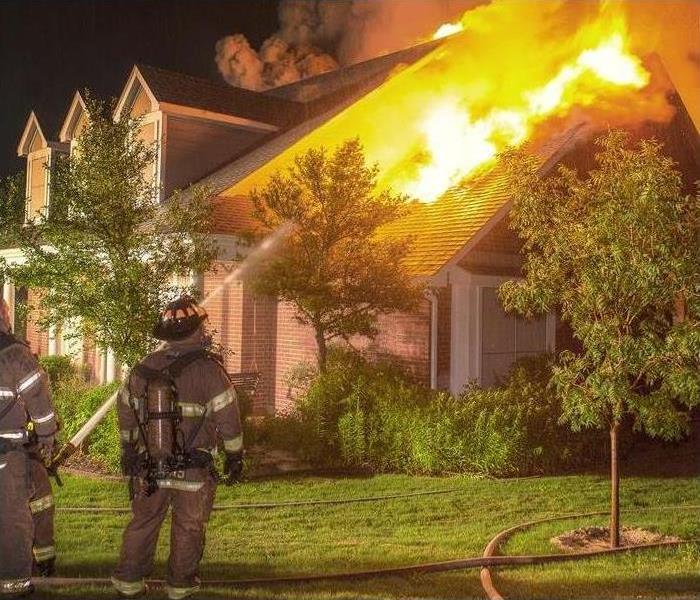
- Ask whether it is safe to enter the home. Do not enter if the fire department hasn't deemed it safe.
- Know who to call.
- Contact family members and let them know you are safe, and unharmed.
- Contact your insurance agent. They will be able to talk you through the necessary steps, including proper documentation and emergency lodging and living expenses (keep all of your receipts!) The insurance company may assist in securing a company to help with clean up options.
- You may request SERVPRO at this time for contents cleaning, restoration etc.
- Another call may be to your landlord if applicable, and to your local American Red Cross.
- Secure the property to prevent possible looting. We are available to assist with securing the property, including boarding up windows and doorways.
- If the fire department used water to put out the fire, drying your home is critical. Water damage can lead to mold damage if not dried properly. SERVPRO is an approved restoration contractor for many major insurance carriers and adheres to the highest standards in the restoration industry.
- Seek counseling if needed. Children and adults can feel a traumatic sense of loss, and may need help to avoid a lasting sense of sadness and disorientation after a house fire. Don’t be afraid to reach out for help. A house fire is a traumatic event and individuals need to be treated with respect and compassion by those close to the process of rebuilding.
For more information on fire damage cleanup, call SERVPRO of the Quad Cities at (256) 383-4470.
Heating Safety Tips
11/27/2018 (Permalink)
Heating equipment is a leading cause of home fire deaths. Half of home heating equipment fires are reported during the months of December, January, and February. Some simple steps from the National Fire Protection Association (NFPA) can prevent most heating-related fires from happening.
- Keep anything that can burn at least three feet away from heating equipment, like the furnace, fireplace, wood stove, or portable space heater.
- Have a three-foot “kid-free zone” around open fires and space heaters.
- Never use your oven to heat your home.
- Have a qualified professional install stationary space heating equipment, water heaters or central heating equipment according to the local codes and manufacturer’s instructions.
- Have heating equipment and chimneys cleaned and inspected every year by a qualified professional.
- Remember to turn portable heaters off when leaving the room or going to bed.
- Always use the right kind of fuel, specified by the manufacturer, for fuel burning space heaters.
- Make sure the fireplace has a sturdy screen to stop sparks from flying into the room. Ashes should be cool before putting them in a metal container. Keep the container a safe distance away from your home.
- Test smoke alarms at least once a month.
Thanksgiving Safety
11/21/2018 (Permalink)
For most, the kitchen is the heart of the home, especially during the holidays. From testing family recipes to decorating cakes and cookies, everyone enjoys being part of the preparations.
So keeping fire safety top of mind in the kitchen during this joyous but hectic time is important, especially when there’s a lot of activity and people at home. As you start preparing your holiday schedule and organizing that large family feast, remember, by following a few simple safety tips you can enjoy time with your loved ones and keep yourself and your family safer from fire.
Thanksgiving by the numbers
- Thanksgiving is the peak day for home cooking fires, followed by Christmas Day, Christmas Eve, and the day before Thanksgiving.
- In 2016, U.S. fire departments responded to an estimated 1,570 home cooking fires on Thanksgiving, the peak day for such fires.
- Unattended cooking was by far the leading contributing factor in cooking fires and fire deaths.
- Cooking equipment was involved in almost half of all reported home fires and home fire injuries, and it is the second leading cause of home fire deaths.
Safety tips
- Stay in the kitchen when you are cooking on the stovetop so you can keep an eye on the food.
- Stay in the home when cooking your turkey and check on it frequently.
- Keep children away from the stove. The stove will be hot and kids should stay 3 feet away.
- Make sure kids stay away from hot food and liquids. The steam or splash from vegetables, gravy or coffee could cause serious burns.
- Keep the floor clear so you don’t trip over kids, toys, pocketbooks or bags.
- Keep knives out of the reach of children.
- Be sure electric cords from an electric knife, coffee maker, plate warmer or mixer are not dangling off the counter within easy reach of a child.
- Keep matches and utility lighters out of the reach of children — up high in a locked cabinet.
- Never leave children alone in room with a lit candle.
- Make sure your smoke alarms are working. Test them by pushing the test button.
Source: NFPA's Fire Analysis & Research Division
Potential Fire Hazards in Your Home
8/28/2018 (Permalink)
A fire can cause devastating damage your home. It’s important to take extra precautions to avoid fire hazards before they cause damage. Often, fires are caused by something that we’ve completely overlooked. Here are a few fire hazards you should look for in your home.
Faulty Wiring
Over 80% of residential electrical fires are a result of faulty wiring behind your walls. Winter months are the most dangerous due to increased usage of lighting and heating appliances. Replace frayed wires and have flickering or hot light switches inspected by an electrician. New infrared technology is available that can determine if there are potential wiring hazards behind your walls.
Cluttered Heating and Storage Areas
Storing too many things in your utility room and around your heating system, boiler, or hot water heater is not a great idea. Investing in exterior storage could prevent a fire in your home.
Overloaded Extension Cords
Extension cords are not permanent outlets. Overloading an extension cord can cause overheating and put your entire home at risk of a fire. Regularly check your extension cords to make sure they are not damaged or broken. Stop using an extension cord immediately if it feels unusually hot.
Dryer Vents
If you notice that your clothes are taking longer than usual to dry it could be a sign that your dryer vent and pipe need servicing. A blocked dryer vent can cause a fire as the hot air attempts to escape. Clean your dryer vents annually and replace the dryer hose.
Electric Blankets
An electric blanket can be cozy in the wintertime, but they are also a fire hazard if left unattended for too long. Make sure your electric blankets are turned off when not in use and do not leave them around pets.
Safe Alternatives for Candles
8/24/2018 (Permalink)
 Keep candles at least a foot away from anything that can burn
Keep candles at least a foot away from anything that can burn
Candles are a common but dangerous household item. According to Alder Home Security, candles are the fourth leading cause of house fires. The National Fire Protection Association reported that there is a report of a candle fire 24 times per day, with about one-third of them beginning in bedrooms. And, around the December holidays, be especially aware if a candle is lit - fires caused by candles spike during the winter season. To safely scent your home in Florence, AL check out the following three candle alternatives.
1. Flameless Candles
Battery-operated flameless candles are a great option for areas of your home that are often vacant, such as hallways, guest rooms and bathrooms. They are often made with scented wax to smell like an authentic candle and flicker as if they were lit with a real flame. Leaving candles unattended or forgetting to blow them out are two of the reasons for 85 percent of fires, according to the National Candle Association, and flame-free candles can be a preventative measure.
2. Luminaries
If you’re looking for an option that looks different than a traditional candle, picking up a flameless luminary is a way to go. It’s made up of a decorated shade, and some brands allow you to choose between different scents. As an added bonus, some types shut off after four hours so you don’t have to remember to turn them off.
3. Candle Warmers
For those who enjoy the look and smell of an authentic candle, candle warmers make great lit candle alternatives. The lamp heats the wax from the candle by warming the top to release its scent. The lamps come in multiple designs and can hold most 22-ounce candles. You may be able to purchase scented candles with or without a wick, or you can heat your own.
Candle alternatives are excellent additions to homes to prevent candle-related fires. These options can still provide the look, smell and cozy atmospheres in your home that traditional candles provide – without the risk.
When Fire Damage to Your Home Needs Reconstruction
8/23/2018 (Permalink)
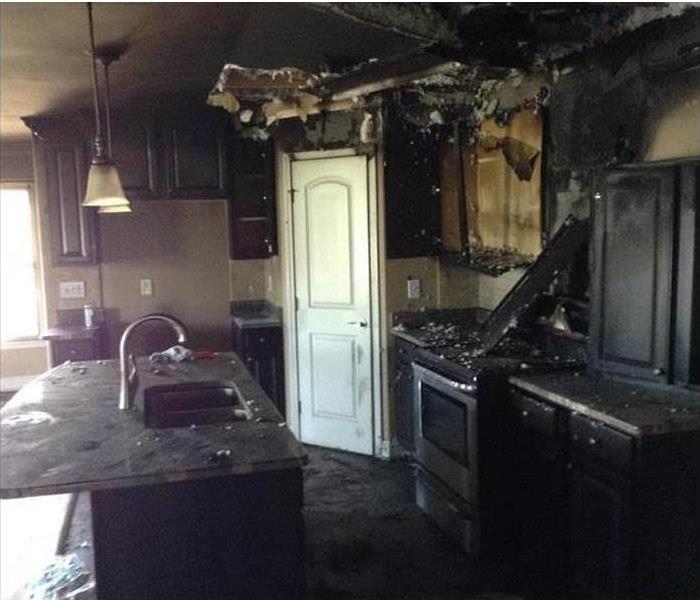 SERVPRO responded to this emergency fire and handled the demolition, mitigation, and construction needs for this customer from start to finish!
SERVPRO responded to this emergency fire and handled the demolition, mitigation, and construction needs for this customer from start to finish!
Our SERVPRO Team Works Hard to Make the Fire Damage Cleanup Process as Easy as Possible for You and Your Family!
There is no easy way to contend with a fire to your Florence home. For many people who have experienced this disaster, the effect on the structure of your home can be overwhelming to see. When it comes to restoring the damages to your home and to reconstruct the weakened portions of your residence following the fire, professional restoration services are more than just highly recommended.
Your Florence home might show its fire damage in several different ways, but the most pressing of any of these issues are the ones that threaten the structural integrity of your home. These issues must be resolved before any of the other problems from the fire, as these make your home unsafe to live in. Fortunately, our SERVPRO technicians get trained in all aspects of fire restoration for houses, including preparation techniques for reconstruction.
The entire process begins with a thorough inspection completed by our experienced SERVPRO professionals. This inspection determines the farthest reaches of the damage from the fire, our approach to restoring the damage from the fire that trouble you and your family, and lastly to assess what areas of your home must get reconstructed or rebuilt to have the structural integrity it once had.
While no one wants to hear that parts of their home must get rebuilt to be safe to live in, our technicians work to make this process as fast and simple as possible for you. Our team utilizes our training in controlled demolition to remove the highly damaged portions of your home and ready these areas for new materials.
It is never an easy thing to deal with the effects of a fire, especially when reconstruction is a requirement, but SERVPRO of the Quad Cities can make this process as easy as it can be. We can restore all of the damage to your home and recontruct the areas with the worst damage. Our emergency response team is available anytime you need us by calling (256) 383-4470.
Click here for information on the Florence Fire Department.
Ten Fire Safety Tips
12/18/2017 (Permalink)
With the Christmas holiday upon us, now is a good time to review some fire safety tips to help you and your family stay safe while celebrating the holiday. Some simple prevention steps can aid in helping you prevent a fire in your home.
1. Watch your cooking - Stay in the kitchen if you are frying, grilling or broiling food. Never allow young children around the stove or oven, especially if they are not closely attended.
2. Give space heaters space - Keep space heaters at least three feet from anything that can burn.
3. Smoke outside - If you must smoke inside, have a sturdy, deep ashtray. Never smoke in bed.
4. Keep matches and lighters out of reach - Keep matches and lighters in high cabinets, preferably under a child lock.
5. Inspect electrical cords - Replace cords that are cracked, damaged, have bro- ken plugs or have loose connections.
6. Be careful when using candles - Keep candles at least one foot from anything that can burn. Blow them out before you leave the room or go to sleep.
7. Have a fire escape plan - Make a fire escape plan and practice it at least twice a year.
8. Install smoke alarms - Install alarms on every level of your office or home and inside bedrooms. Interconnect them so they all sound at once.
9. Test smoke alarms - Test alarms once per month. Replace batteries once per year or as needed.
10. Install sprinklers - Sprinklers can help maintain and sometimes even extinguish fires, giving your local fire department a better chance of saving your property.
Christmas Tree Safety Tips
11/28/2017 (Permalink)
 As you deck the halls this holiday season, be fire smart. A small fire that spreads to a Christmas tree can grow large very quickly.
As you deck the halls this holiday season, be fire smart. A small fire that spreads to a Christmas tree can grow large very quickly.
Statistics from the National Fire Protection Association (NFPA) show the holidays are a high-risk time for home fires. Christmas trees are responsible for 240 home fires each year, and other holiday decorations are the cause of another 1,170 fires.
Here are some tips to keep your home safe this holiday season:
•Check the stand daily to make sure that the level of water does not go below the base of the tree.
•Keep trees at least three feet away from major sources of heat (fireplaces, heaters, heat vents, and direct sunlight). Lowering the room temperature will slow the drying process.
•Use lights that produce low heat, such as miniature lights, to reduce drying of the tree.
•Always inspect light sets before placing them on the tree. If worn, replace with a new set.
•Do not overload electrical circuits.
•Always turn off the tree lights when leaving the house or when going to bed.
•Monitor the tree for freshness. After Christmas or if the tree is dry, remove it from the house.
•Install and ensure smoke alarms work inside and outside each bedroom and sleeping area. Install alarms on every level of the home, including the basement.
If you do have a fire, please refer to our Fire Damage Tips - Until Help Arrives Guide and follow these tips to protect yourself and your property.
Have Questions? Call Us Today – (256) 383-4470
Winter Fire Safety
11/22/2017 (Permalink)
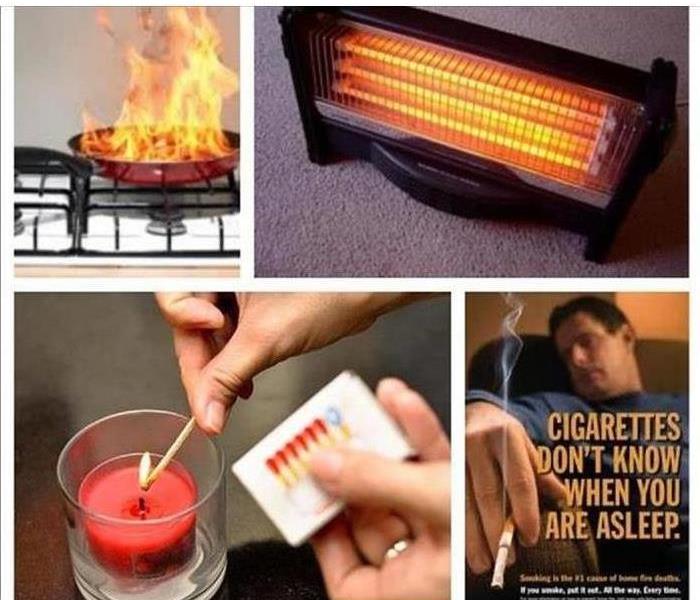 We want you to stay warm and cozy this winter, but we also want you to stay safe.
We want you to stay warm and cozy this winter, but we also want you to stay safe.
It's getting a little chilly at night in Florence! The winter season is just around the corner. Homes fires occur more often by unattended candles, space heaters, wood stoves and fireplaces.
At SERVPRO of the Quad Cities, we want to remind everyone to take simple steps to protect their homes and family from the danger of household hazards and heating equipment. Practicing the best fire safety is how you can be most prepared for unexpected disaster in the winter.
Here are some fire safety tips to prevent most heating related fires from happening:
- Keep anything that can burn at least 3 feet away from heating equipment, like the furnace, fireplace, wood stove, or portable space heater.
- Have your chimneys and vents checked. Fireplaces produce creosote which can ignite. If you light fires frequently, you need a chimney sweep service once a year. When you burn wood, make sure it's dry and seasoned so that it produces more flame and less smoke.
- Make sure the fireplace has a sturdy screen to stop sparks from flying into the room. Ashes should be cool before putting them in a metal container. Keep the container a safe distance away from your home.
- Test smoke alarms. Make sure batteries are fresh. Place smoke alarms in the kitchen, laundry room and in bedrooms.
- Beware of lit candles. Candles can set the mood for relaxation, and that's how they get forgotten or knocked over by kids or pets. Light candles only when you're around to watch them and blow them out when you're ready to leave the room.
- Beware of space heaters. The name should give you a clue space heaters need space. Like fireplaces, people and pets should not be allowed to sit any closer than 3 feet.
- Don't put space heaters near curtains, tablecloths or other fluttering fabrics. Make sure the space heaters you buy have automatic shut-offs before reaching dangerous temperatures.
If you have the unfortunate experience of fire or smoke damage in your home or business call SERVPRO of the Quad Cities.
Florence Smoke and Soot Cleanup
8/29/2017 (Permalink)
 Smoke and Soot Damage Can Cause a Pervasive Odor in Your Florence Home.
Smoke and Soot Damage Can Cause a Pervasive Odor in Your Florence Home.
Smoke and soot is very invasive and can penetrate various cavities within your home, causing hidden damage and odor. Our smoke damage expertise and experience allows us to inspect and accurately assess the extent of the damage to develop a comprehensive plan of action.
Smoke and soot facts:
- Hot smoke migrates to cooler areas and upper levels of a structure.
- Smoke flows around plumbing systems, seeping through the holes used by pipes to go from floor to floor.
- The type of smoke may greatly affect the restoration process.
Different Types of Smoke
There are two different types of smoke–wet and dry. As a result, there are different types of soot residue after a fire. Before restoration begins, SERVPRO of the Quad Cities will test the soot to determine which type of smoke damage occurred. The cleaning procedures will then be based on the information identified during pretesting. Here is some additional information:
Wet Smoke – Plastic and Rubber
- Low heat, smoldering, pungent odor, sticky, smeary. Smoke webs are more difficult to clean.
Dry Smoke – Paper and Wood
- Fast burning, high temperatures, heat rises therefore smoke rises.
Protein Fire Residue – Produced by evaporation of material rather than from a fire
- Virtually invisible, discolors paints and varnishes, extreme pungent odor.
Our Fire Damage Restoration Services
Since each smoke and fire damage situation is a little different, each one requires a unique solution tailored for the specific conditions. We have the equipment, expertise, and experience to restore your fire and smoke damage. We will also treat your family with empathy and respect and your property with care.
Have Questions about Fire, Smoke, or Soot Damage?
Call Us Today – 256-383-4470
Repairing Your Property After A Fire
8/25/2017 (Permalink)
Has your home recently been damaged by fire? If so, you’re probably eager to get started cleaning up and restoring your home and belongings. Most people who suffer fire damage want their lives and their homes to return to normal as soon as possible. But many don’t know the costs. According to HomeAdvisor, the average cost to repair smoke and fire damage is $8,571.
Fire damage can make areas of your home unusable until the fire damage has been repaired. More extensive fire damage may make your entire home unsafe and you may have to live in temporary housing or with relatives until cleanup and repair work is completed. No matter how minor or significant the fire damage restoration work is, you want to know how long it will take. The timeline depends on the restorative process and whether you take the opportunity to do remodeling at the same time.
Starting Fire Damage Repair Work
It can be difficult to determine how and where to get started with fire damage repair work. The first step in the repair process is to remove water from the home if firefighters used water during the extinguishing process. Water extraction can be completed by the professionals from SERVPRO of the Quad Cities quickly and properly. We arrive in our green vehicles stocked with equipment and supplies to tackle any cleaning and restoration need you have.
Other Things To Consider
SERVPRO of the Quad Cities can also suggest to you and your adjuster what items and materials are salvageable. Keep in mind that smoke damage can also be a problem. Some items, such as carpeting and your HVAC system, may need to be professionally cleaned to remove the smoke odor from your home.
Get Professional Help
Repairing your home after you have suffered fire damage is not something that you want to attempt on your own. A fire damage restoration project requires a considerable amount of time and energy to complete. SERVPRO can help you restore your property in minimal time with minimal costs. Our IICRC certified cleanup and restoration technicians have the skills and assets to do a quality job. We are a locally owned and operated water and fire damage repair franchise.
Call SERVPRO of the Quad Cities at (256) 383-4470 Anytime
First Steps After Fire Damage
8/24/2017 (Permalink)
 Grease Fire
Grease Fire
How do you clean up after fire damage?
First, consider your safety. Only stay in your fire damaged home if you know it’s safe. Remember that electrical and "slip and fall" hazards are some of the most common ways people get injured after a fire.
If putting the fire out has left lots of water on your property, avoid lifting wet materials. They could be much heavier than you think. When fire has damaged your property, some of the first steps you should take are:
What To Do After Fire Damage
• Limit movement in your home to prevent soot particles from being embedded into upholstery and carpets.
• Keep everyone’s hands clean so you don’t further soil upholstery, walls, and woodwork.
• Place clean towels or old linens on rugs, upholstery, and carpet traffic areas.
• If your electricity is off, empty your freezer and refrigerator and prop the doors open.
• Clean and protect chrome with a light coating of petroleum jelly or oil.
• Wash your houseplants on both sides of leaves.
• Change your HVAC filter.
• Tape double layers of cheesecloth over air registers.
What NOT To Do After Fire Damage
• Don't try to wash any walls or painted surfaces or shampoo your carpet or upholstery without contacting a professional. You may do more damage.
• Don't attempt to clean any electrical appliances that may have been close to fire, heat, or water without consulting an authorized repair service.
• Don't use any canned or packaged food or beverages that may have been stored near the fire, heat, or water.
• Don't turn on ceiling fixtures if the ceiling is wet. The wiring may be damaged.
• Don't send garments to an ordinary dry cleaner. Improper cleaning may set smoke odor.
Remember, we’re here to help. We are fire restoration contractors. Many people in the Florence/Muscle Shoals region have used our professional fire restoration services. So call SERVPRO of the Quad Cities anytime, 24/7 at 256-383-4470.
Christmas Season Reminder
12/19/2016 (Permalink)
The holidays are in full swing as people are finishing up last minuet shopping for gifts and decorations are all around us. Here at SERVPRO of the Quad Cities want to make sure that everyone has a safe Holiday. We took some time to find some tips and tricks to keep your home and family safe.
Water the Tree:
If you have a live Christmas tree in your home if not taken care of can lead to a fire that can damage your home. Even small fires create smoke that can have lasting affects.
- When you bring your tree home make sure you cut off the bottom of the tree to open the pours so the tree adsorbs the water properly.
- Make sure the tree is not by any heaters or warm vents.
- Fill the stand with water. This is something you will have to check every day and multiple times a day when you first bring it home. The tree can soak up to a gallon of water the first day. You want to make sure the level of water is never below the base.
Keeping your family and home safe is our number one priority.
What you can do until help arrives after a fire
7/11/2016 (Permalink)
DO:
- Limit movement in the home to prevent soot particles from spreading and additional damage from occurring.
- Place clean towels or old linens on rugs and high traffic areas and upholstery.
- Coat chrome faucets, trim and appliances with petroleum jelly or oil.
- Place aluminum foil or wood blocks between furniture legs and wet carpet.
DO NOT:
- Wash any walls or painted surfaces.
- Shampoo carpet or upholstery.
- Clean any electrical equipment.
- Send clothing to dry cleaner since improper cleaning may set smoke odor.
10 Fire Safety Tips
7/11/2016 (Permalink)
1. Watch your cooking - Stay in the kitchen if you are frying, grilling or broiling food. Never allow young children around the stove or oven, especially if they are not closely attended.
2. Give space heaters space - Keep space heaters at least three feet from anything that can burn.
3. Smoke outside - If you must smoke inside, have a sturdy, deep ashtray. Never smoke in bed.
4. Keep matches and lighters out of reach - Keep matches and lighters in high cabinets, preferably under a child lock.
5. Inspect electrical cords - Replace cords that are cracked, damaged, have bro- ken plugs or have loose connections.
6. Be careful when using candles - Keep candles at least one foot from anything that can burn. Blow them out before you leave the room or go to sleep.
7. Have a fire escape plan - Make a fire escape plan and practice it at least twice a year.
8. Install smoke alarms - Install alarms on every level of your office or home and inside bedrooms. Interconnect them so they all sound at once.
9. Test smoke alarms - Test alarms once per month. Replace batteries once per year or as needed.
10. Install sprinklers - Sprinklers can help maintain and sometimes even extinguish fires, giving your local fire department a better chance of saving your property.






 24/7 Emergency Service
24/7 Emergency Service

























